

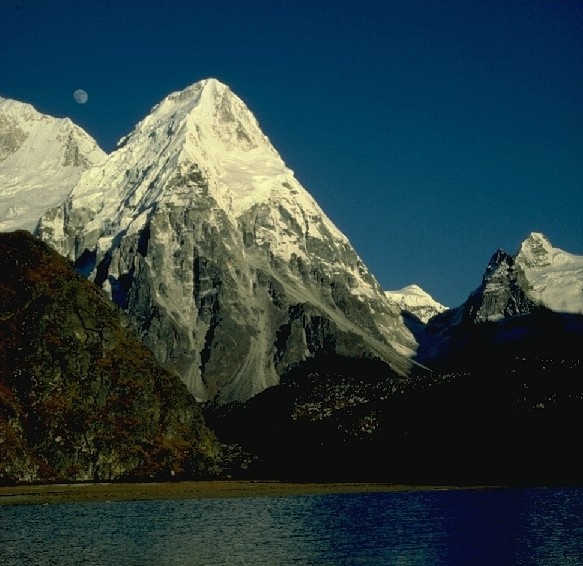
Why Nepal?
I have been trekking in several places of the world, but so far, I haven't found a natural scenery comparable to that of Nepal !
It's the country with the world's highest mountain chain with several peaks over 8.000 meters above sea level. It's the country where the daily life of the tribes in many of the villages is still quite close to that of the middle ages. It's the country where walking is not done for pleasure but for basic transport because most of Nepal is still without roads and vehicles.
And the nature and the isolation is what makes Nepal a Mekka for trekkers. Few westeners, who have made a real trek in the mountains of Nepal, return to their home country without being deeply influenced by the strong impressions you get out there. The hippies were among the first foreigners to discover the magic attractions of Nepal in the sixties when they were virtually the only tourists in the country.
Since then, the number of visitors has grown to enormous quantities. In 1952 there were 562 tourists, in 1964 the number had grown to about 10.000, in 1968 there were more than 20.000, and to-day, the tourism has almost exploded.
Kathmandu HAS become a modern town with all the good and bad consequences of that, but the Kathmandu valley itself and the old part of the town are absolutely worth visiting. And the mountains of Nepal with its hundreds of villages and numerous tribes and languages will still keep their peace and tranquility for many many years.
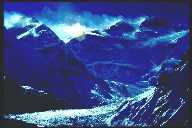
|
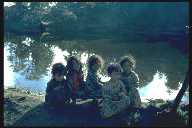
|
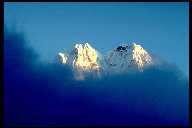
|
Above, left:
Kanchenjunga is the third highest mountain in the world (8.835 m). You
find it in the Himalayas of eastern Nepal, very close to the place where the borders of
Tibet, Sikkim and Nepal meet.
We reached the foot of the mountain after 2 weeks of trekking through
beautiful mountain areas and villages totally untouched by tourists.
This photo was taken at the Kanchenjunga base camp Pang Pema,
at an altitude of 5.200 meters above sea level.
Above, middle:
On the way to Kanchenjunga, we met people and villages totally
untouched by foreigners.
Above, right:
An experience you never forget! After a cloudy afternoon,
the sky is brightening towards the evening, revealing one of the many seven thousanders at
a very close distance - here the peak of Jannu.
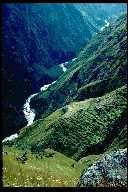
|
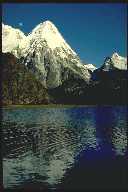
|
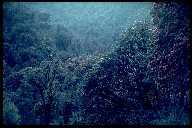
|
Above, left:
Trekking the long way up through the deep Ghunsa valley, eastern Nepal. This
part took us several days, and all the time, we had the sound of the river in our years.
Above, middle:
Sunset and moonrise at the pastures of Lapsang, close to Kanchenjunga, eastern Nepal. The mountain
to the left is Ratong Peak (6.678 meters). The pass to the right is leading into the
neighbouring country of Sikkim.
Above, right:
The flowering rhododendron forests are among the most attractive sights for trekkers during the
spring time in the Himalayas - here at dusk time near the Gorapani Pass on the Jomosom Trail,
about half way between Pokhara and Jomosom.
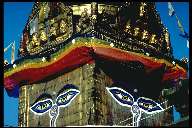
|
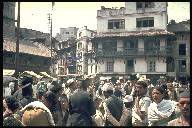
|
Above, left:
The Swayambhunath-temple (better known as the Monkey Temple) is situated on top of a hill west of Kathmandu and is the oldest temple in the Kathmandu valley.
Above, right:
From the centre of Kathmandu, the capital of Nepal.
Kathmandu is situated at an altitude of about 1.350 meters. The population in the Kathmandu valley consists of many different tribes, but the newars is the dominating group. Almost all the men are wearing the traditional topi on their heads. In the background, you see a typical newar house, with wooden balconies and roofs above.
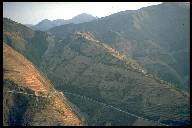
|
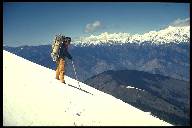
|
Above, left: On the road from India to Kathmandu.
From the Indian border, I took a bus from the town Raxaul to Kathmandu, the capital of Nepal. This 130 km long road was opened in 1953. After a couple of hours through the flat Terai region with forest, we reached the Himalayan foothills and started to climb. Few bus trips have ever impressed me more than this one! - Just the thought of being in Nepal for the first time was fabulous! The photo was taken in the afternoon sun and shows part of the fantastic road surrounded by rice fields.
Above, right: From a trek in the Gosainkund area north of the Kathmandu valley.
My first trek ever in the Himalayas went to the holy lakes of Gosainkund - a beautiful trekking area north of the Kathmandu valley and close to the Langtang mountain (7.250 meters).
On this day, we started from one of the Gosainkund lakes, heading for the village of Dhunche. We walked downwards for 9 hours: In the beginning passing naked slopes of snow, later through pine forest and finally through hardwoods to Dhunche in the bottom of a narrow valley
with subtropical climate. It's our sherpa Pemba in the foreground. From this area, you could overlook a major part of the Himalayan chain with hundreds of peaks - some of them even in Tibet.
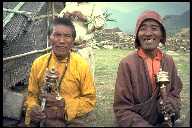
|

|
Above, left: Tibetan refugees with prayer mills near Pokhara.
Above, right: From the village of Tukucha in the Thakkhola Valley, at the Jomosom Trail.
We reached the village of Tukucha in the Thakkhola Valley (between Dhaulagiri and Annapurna) after 6 days of trekking. This valley is primarily inhabited by the Thakali tribe, who mostly live on trade, since the climate in the valley is very dry and not good for agriculture. The Thakali Valley is part of one of the very old caravan routes between the south and Tibet / Mustang. Due to the dry climate, the architecture of the houses is very different from the rest of Nepal. The houses are white, with flat roofs and atrium courtyards.

|
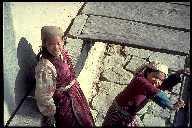
|
Above, left: From the sherpa village Tarke Gyang (2.500 meters), north of the Kathmandu Valley.
The big building to the left is the monastary of the village. And everywhere, especially around
the monastery and the prayer wall in the foreground, you see buddhist prayer flags.
Above, right: Sherpa girls from Tarke Gyang.
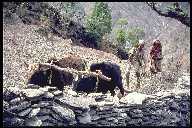
|
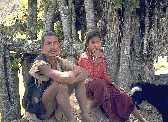
|
Above, left: Family working in their field near Tatopani, on the Jomosom trail.
the daily life of the tribes in many of the villages is still quite close to that of
the middle ages - like on this photo. The woman behind the plough is sowing the new crop.
Above, right: Nepalese family resting under a shady tree.
Return to the Photo Gallery main page